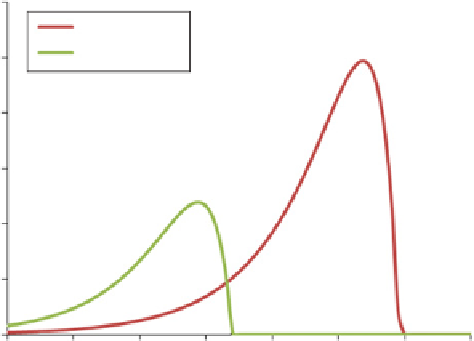Environmental Engineering Reference
In-Depth Information
Thermophilic
Mesophilic
10
20
30 40
Temperature (°C)
50
60
70
80
FIGURE 14.5
Biomass-specific substrate conversion rates (
q
-rates) as a function of
temperature. Two types of microorganisms with a different optimum temperature can be
identified: mesophilic (38
C) and thermophilic (65
C).
The influence of the temperature on biomass-specific conversion rates (
q
-rates,
g
substrate
h
−1
) is shown in Figure 14.5. The figure shows that below the optimum
temperature of both mesophilic and thermophilic microorganisms, the
q
-rates increase
with increasing temperature. At temperatures exceeding the optimum temperature, the
q
-rates rapidly decrease. Figure 14.5 also shows that in the mesophilic temperature
range, the thermophilic microorganisms have lower
q
-rates than mesophilic micro-
organisms, explaining the dominance of mesophilic microorganisms at moderate
temperatures. Furthermore, it is evident that the maximum
q
-rates as established at
the optimum temperature are significantly higher for thermophilic than for mesophilic
microorganisms.
Compared to aerobic (combustion) processes, the effect of microbial metabolic
activity on the temperature of the process is limited because the enthalpy effects of
anaerobic digestion are small and normally the temperature increase due to biological
activity is negligible. Furthermore, biogas produced during anaerobic digestion is sat-
urated with water resulting in a decrease of the temperature of the bioreactor. Overall,
this means that for most substrates the bioreactor (or the substrate) needs to be heated
in order to maintain the mesophilic or thermophilic temperatures required.
In practice, anaerobic digesters are operated at both mesophilic and thermophilic
temperatures. Retention times typically are shorter in thermophilic digesters (10
g
−1
biomass
−
20 days)
than in mesophilic digesters (20
40 days) due to the higher biomass-specific conver-
sion rates, reducing the bioreactor volume required. For hygienization of the digestate
of anaerobic digesters, as required for reuse of the material in agriculture, the
feedstock needs to be heated to 70
C and kept at that temperature for a short period
of time (10
−
−
30 min). Depending on country-dependent legislation, hygienization is









Search WWH ::

Custom Search